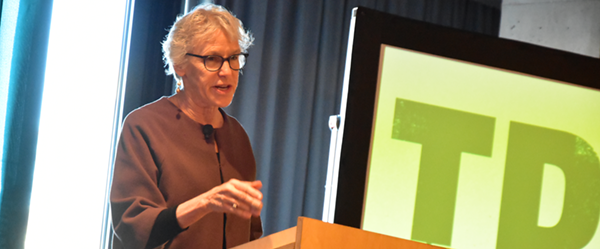The second day’s session dove into two major issues: gender in the workplace and democratizing finance. Stacey Faella of the Woodcock Foundation (and Confluence board member) introduced Joan Williams, Hastings Law professor, the keynote speaker. Williams is the author of over 11 books and her article “What So Many People Don’t Get About the U.S. Working Class” has been read over 3.7 million times. She is recognized as one of world’s leading scholars on gender in the workplace and has reshaped the conversation on work, gender, and class. Williams is described as a “rockstar” in her field by The New York Times.
Williams introduced her remarks by graciously recognizing Confluence Philanthropy as a “visionary organization” and shared that she had a fascinating few days with us. Then she introduced the subject that has occupied her professionally for well over a decade: identifying and interrupting bias in the workplace.
When it comes to bias, we all know the stories. Women and people of color have to work twice as hard to get half as far. They have to prove themselves repeatedly in the workplace. Their ideas are ignored until championed or stolen by other colleagues; oftentimes, a white male colleague.
Williams explained that women walk a tightrope: if they are seen as too feminine, they are not taken seriously; if they are seen as too masculine, they are not likeable. And their competence is always suspect: when a man gets promoted, he is skilled. When a woman does, she is lucky.
For over 40 years, Williams said, hundreds of studies have documented such patterns of bias. She wondered whether these findings applied to the workplace environment. She began testing, and affirming, these findings among women in leadership positions. Ninety-six percent of the women she spoke to expressed affirmation.
Williams then posed a second question: “What has helped you navigate these subtle forms of bias?” She developed her findings into a model called Bias Interrupters, filled with strategies to help individuals and institutions interrupt bias—“things anyone can do starting today in your workplace.”
The need is huge, she said. After making tremendous strides in the workplace from 1975 to 1995, “women have stalled out at 14% at the top of virtually every industry. This has happened to people of color, too.”
Metrics, Williams says, are key to fixing the problem. “Be careful,” she warns. Organizations should not just do a “body count,” measuring how many women or people of color work there. “That is important,” she says, “but it does not express what is wrong with your organization or how to fix it.”
Instead, she offers free, open-source toolkits for institutions to document and then take steps to interrupt bias. She proposes a four-step process:
-
First, do an evidence-based assessment of what kinds of bias people think are happening in your workplace.
-
Second, develop an objective metric to measure for this bias.
-
Third, implement a bias interrupter.
-
Fourth, return to the metric. If you haven’t made progress, return to Step 3.
Social networks are typically driven by in-group favoritism, which determines who gets opportunities and support in the form of resources—and even who gets the benefit of the doubt. Her four-step method can help interrupt many types of bias, including the disproportionate saddling of women with “office housework” bias; interview and hiring bias; and performance evaluation bias. “If you’re not monitoring for bias in performance evaluations,” says Williams, “it’s probably happening.” This is, of course, one of the root causes of pay inequity, among other egregious patterns.
The costs of not addressing bias are huge for workers. In one study, identical resumes were submitted to recruiters. The only difference was that one included the woman’s PTA membership on her list of accomplishments. Based on that one difference (which signaled the woman was a mother), the woman was 79% less likely to be hired, was offered $11,000 less, and was seen as less competent.
“The problem is not the capacity of women and people of color—bias is being transmitted through business systems,” she explains. To address bias, businesses need to use an approach that is evidence-based and metrics-driven. Williams concluded by saying, “The connection with Confluence is that if you are investing with a gender lens, this is a gender lens that promises to deliver.”









